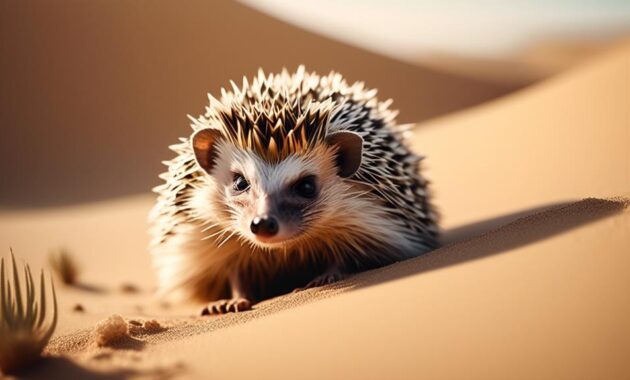
The occurrence of hybridization between a rare species and the European hedgehog has sparked considerable interest among researchers and conservationists alike. With the southern white-breasted hedgehog exhibiting distinct characteristics and behavior, the discovery of their ability to hybridize with their European counterparts raises intriguing questions about the genetic and ecological implications of such interbreeding.
As we delve into the details of this unique phenomenon, we will explore the potential consequences for both species, the implications for their conservation, and the broader implications for our understanding of hybridization in the natural world.
The intricate interplay between these two species and the mysteries it unravels make this a topic worthy of further investigation.
Key Takeaways
- The southern white-breasted hedgehog and European hedgehog can hybridize.
- The southern white-breasted hedgehog does not dig dens like the European hedgehog, preferring to build grass nests in secluded areas.
- The southern white-breasted hedgehog carries ectoparasites such as ticks and fleas.
- The increasing popularity of the southern white-breasted hedgehog as an exotic pet raises concerns about potential transmission of zoonotic diseases.
Description and Taxonomy
The Description and Taxonomy of the southern white-breasted hedgehog involve recognizing its distinguishing features and classifying it as a separate species from the European hedgehog (E. europaeus).
Similar in lifestyle and appearance to the European hedgehog, the southern white-breasted hedgehog sets itself apart with a white spot on its chest.
While it was initially believed that the southern and northern white-breasted hedgehogs were the same species, further investigations have established them as distinct species.
Interestingly, the southern white-breasted hedgehog is capable of hybridizing with the European hedgehog.
It is important to note that the northern white-breasted hedgehog is found in Eastern Europe and Russia.
Understanding the taxonomy and characteristics of the southern white-breasted hedgehog is crucial for accurately identifying and differentiating this species from its European counterpart.
Physical Characteristics
Featuring distinct physical attributes, the southern white-breasted hedgehog possesses unique characteristics that distinguish it from the European hedgehog. These physical characteristics include:
- A white spot on its chest, which sets it apart from the European hedgehog.
- Similar lifestyle and appearance to the European hedgehog, but with subtle differences.
- The ability to hybridize with the European hedgehog, indicating close genetic relationship.
These physical traits highlight the species’ individuality and its potential for interbreeding with the European hedgehog. Understanding these differences is crucial for accurately identifying and conserving these rare species.
Recognition as Different Species

After conducting newer investigations, it has been recognized that the southern white-breasted hedgehog and the northern white-breasted hedgehog are different species. Previously, they were considered the same species due to their similarities in lifestyle and appearance to the European hedgehog.
However, further research and analysis have revealed distinct differences between the two hedgehog species. The southern white-breasted hedgehog, unlike its European counterpart, does not dig dens but prefers to build grass nests in secluded areas. This difference in behavior is one of the factors that contributed to the recognition of these hedgehogs as separate species.
Additionally, the ability of the southern white-breasted hedgehog to hybridize with the European hedgehog further highlights their taxonomic distinction. These findings have significant implications for the understanding and conservation of these unique hedgehog species.
Hybridization With European Hedgehog
Hybridization between the southern white-breasted hedgehog and the European hedgehog is an intriguing phenomenon that allows for genetic exchange between these distinct species. This process has several interesting implications:
- Genetic Variation: Hybridization can introduce new genetic material into the populations of both species, leading to increased genetic diversity and potentially enhancing their ability to adapt to changing environments.
- Ecological Consequences: The hybrid offspring may possess a unique set of traits that could impact their ecological niche and interactions with other species. Understanding the ecological consequences of hybridization is essential for conservation efforts and managing potential conflicts.
- Conservation Concerns: Hybridization can pose challenges for the conservation of both species, as it may lead to the dilution of genetic purity and the loss of unique genetic traits. Conservation strategies should consider the management of hybrid populations to ensure the long-term survival of both species.
Further research is needed to fully understand the implications of this hybridization event and its potential impact on the southern white-breasted hedgehog and the European hedgehog populations.
Distribution and Habitat

The distribution and habitat of the southern white-breasted hedgehog and the European hedgehog are key factors in understanding their ecological requirements and conservation needs.
The European hedgehog is widely distributed across Europe, as well as parts of Asia and North Africa. It can be found in a variety of habitats, including woodlands, grasslands, and suburban areas.
In contrast, the southern white-breasted hedgehog has a more restricted distribution, mainly occurring in parts of Iran and Iraq. It prefers arid and semi-arid habitats, such as deserts and rocky areas.
Understanding the specific distribution and habitat preferences of these hedgehog species is crucial for effective conservation efforts, as it allows for targeted conservation strategies to be implemented to protect their populations and ensure their long-term survival.
Behavioral Differences
Understanding the behavioral differences between the southern white-breasted hedgehog and the European hedgehog is essential for gaining comprehensive knowledge about these species. While they may appear similar, there are distinct behavioral variations that set them apart. Here are some notable differences:
- The European hedgehog is known for its habit of digging dens, whereas the southern white-breasted hedgehog does not engage in this behavior.
- Unlike its European counterpart, the southern white-breasted hedgehog prefers to build grass nests in secluded areas.
- The southern white-breasted hedgehog exhibits different behavior patterns compared to the European hedgehog, emphasizing its unique ecological adaptations.
Nesting Behavior

Nesting behavior in the southern white-breasted hedgehog differs significantly from that of the European hedgehog, as it prefers to construct grass nests in secluded areas rather than engaging in the digging behavior characteristic of its European counterpart.
Unlike the European hedgehog, which digs dens for nesting, the southern white-breasted hedgehog seeks out secluded areas to build its nests. These nests are made predominantly from grass, providing a soft and comfortable environment for the hedgehog.
This nesting behavior is a notable difference between the two species, highlighting their distinct adaptations and preferences. By constructing grass nests in secluded areas, the southern white-breasted hedgehog ensures a safe and secure shelter, allowing it to thrive in its natural habitat.
Ectoparasites and Zoonotic Diseases
What are the implications of the southern white-breasted hedgehog’s ectoparasites and its popularity as an exotic pet in terms of potential zoonotic disease transmission?
- The southern white-breasted hedgehog is known to carry ectoparasites such as ticks and fleas.
- These ectoparasites are commonly found on this species and can transmit zoonotic diseases.
- The increasing popularity of the southern white-breasted hedgehog as an exotic pet raises concerns about the potential transmission of these diseases to humans.
Zoonotic diseases are infectious diseases that can be transmitted between animals and humans. The presence of ectoparasites on the southern white-breasted hedgehog increases the risk of zoonotic disease transmission, especially when these hedgehogs are kept as pets.
Pet owners should be aware of the potential health risks associated with these ectoparasites and take appropriate measures to prevent disease transmission. Regular veterinary check-ups, proper hygiene practices, and effective parasite control are essential to minimize the risk of zoonotic diseases.
Impact of Exotic Pet Trade

The increasing popularity of the southern white-breasted hedgehog as an exotic pet raises significant concerns regarding the potential environmental and ecological impacts associated with the exotic pet trade. The demand for these hedgehogs as pets can lead to detrimental effects on their natural habitats and populations. As more individuals are captured and transported for the pet trade, their populations in the wild may decline, disrupting the delicate balance of ecosystems. Furthermore, the release of these exotic pets into non-native environments can have severe consequences. They may outcompete native species for resources, introduce diseases, or hybridize with closely related species, potentially leading to genetic contamination and loss of biodiversity. The table below highlights some of the key impacts of the exotic pet trade:
| Impact | Description | Example |
|---|---|---|
| Habitat Destruction | Capture of individuals can lead to habitat destruction as traders search for more specimens. | Deforestation for the construction of enclosures. |
| Population Decline | Overexploitation for the pet trade can result in a decline in the population of the species. | Reduced numbers in the wild due to high demand for pets. |
| Introduction of Invasive Species | Released exotic pets can establish populations in non-native habitats, outcompeting native species. | Burmese pythons in the Florida Everglades, preying on native wildlife. |
| Disease Transmission | Exotic pets may carry diseases that can be transmitted to native wildlife or humans. | Transmission of salmonella from pet reptiles to humans. |
| Genetic Contamination and Biodiversity Loss | Hybridization with closely related species can lead to genetic contamination and loss of biodiversity. | Hybridization between domestic cats and endangered wildcats, resulting in diluted gene pool. |
These impacts highlight the need for responsible pet ownership and stricter regulations on the exotic pet trade to mitigate the potential negative consequences on ecosystems and biodiversity.
Scientific References
Scientific literature provides valuable information and insights into the taxonomy, behavior, and ecological impact of the southern white-breasted hedgehog. Researchers have conducted extensive studies on this species to understand its characteristics and interactions with its environment.
To gain a comprehensive understanding of the southern white-breasted hedgehog, the following scientific references can be consulted:
- Hutterer, R. (2005). Mammal Species of the World: A Taxonomic and Geographic Reference: This comprehensive reference provides detailed information on the taxonomy and distribution of the southern white-breasted hedgehog.
- Amori, G.; Hutterer, R.; Kryštufek, B.; Yigit, N.; Mitsainas, G.; Palomo, L. (2021). IUCN Red List of Threatened Species: The IUCN Red List contains valuable data on the conservation status and threats faced by the southern white-breasted hedgehog.
These references provide taxonomic, geographic, and conservation-related information, allowing researchers and enthusiasts to deepen their knowledge about this unique species.
Similarities to European Hedgehog

The southern white-breasted hedgehog shares notable similarities with the European hedgehog, including its appearance and lifestyle. Both species have a similar body structure, with a stout body covered in spines that provide protection against predators. They both have a pointed snout, small eyes, and rounded ears. In terms of lifestyle, both hedgehogs are nocturnal and primarily insectivorous, feeding on a diet of insects, worms, and other small invertebrates. They are also solitary animals that prefer to live in secluded areas such as woodlands, gardens, and hedgerows. However, one distinguishing feature of the southern white-breasted hedgehog is the presence of a white spot on its chest, which sets it apart from the European hedgehog.
To further illustrate the similarities between the two species, here is a table highlighting their shared characteristics:
| Characteristic | Southern White-Breasted Hedgehog | European Hedgehog |
|---|---|---|
| Appearance | Stout body with spines | Stout body with spines |
| Lifestyle | Nocturnal, insectivorous | Nocturnal, insectivorous |
| Habitat preference | Secluded areas | Secluded areas |
| Distinguishing feature | White spot on chest | – |
Through their shared appearance and lifestyle, the southern white-breasted hedgehog and the European hedgehog demonstrate their close relationship and common evolutionary traits.
Lifestyle and Habitat Comparison
Differences in lifestyle and habitat preferences distinguish the southern white-breasted hedgehog from its European counterpart. While both species share similarities in appearance and behavior, there are distinct variations in their way of life.
Lifestyle and habitat comparison:
- Nesting behavior: Unlike the European hedgehog, the southern white-breasted hedgehog does not dig dens. Instead, it seeks out secluded areas to build grass nests, preferring this method of shelter.
- Habitat preference: The southern white-breasted hedgehog exhibits a preference for diverse habitats, including woodland edges, shrublands, and grassy areas. This distinguishes it from the European hedgehog, which tends to inhabit more urban and suburban environments.
- Dietary preferences: The southern white-breasted hedgehog has a broader dietary range, consuming not only invertebrates but also small vertebrates and plant matter. In contrast, the European hedgehog primarily feeds on invertebrates.
These differences demonstrate the adaptability and versatility of the southern white-breasted hedgehog in various habitats, making it a fascinating species to study and conserve.
Conservation and Threat Status

The conservation and threat status of the southern white-breasted hedgehog is a critical aspect that requires attention due to its unique lifestyle and habitat preferences.
As a distinct species, it faces specific challenges that need to be addressed for its long-term survival. Currently, there is limited information available regarding the population size and distribution of this hedgehog species.
However, its habitat is under threat from human activities such as habitat destruction, urbanization, and agricultural expansion. Additionally, the increasing popularity of the southern white-breasted hedgehog as an exotic pet raises concerns about potential negative impacts on wild populations.
Efforts should be made to better understand the population dynamics, establish protected areas, and promote responsible pet ownership to ensure the conservation of this rare species.
Frequently Asked Questions
How Does the Southern White-Breasted Hedgehog Differ in Physical Appearance From the European Hedgehog?
The southern white-breasted hedgehog differs from the European hedgehog in physical appearance by having a distinguishing white spot on its chest. This species exhibits similar lifestyle traits to the European hedgehog and can hybridize with it.
What Are the Behavioral Differences Between the Southern White-Breasted Hedgehog and the European Hedgehog?
The southern white-breasted hedgehog exhibits different behavior compared to the European hedgehog. It does not engage in digging dens like its European counterpart, instead seeking out secluded areas to build grass nests.
How Common Is Hybridization Between the Southern White-Breasted Hedgehog and the European Hedgehog?
Hybridization between the southern white-breasted hedgehog and the European hedgehog occurs, but its frequency is not well-established. Further research is needed to determine the prevalence and impact of hybridization between these two species.
What Are the Potential Zoonotic Diseases That Can Be Transmitted by the Southern White-Breasted Hedgehog?
Potential zoonotic diseases that can be transmitted by the southern white-breasted hedgehog include those carried by ectoparasites such as ticks and fleas. The species’ popularity as exotic pets increases the risk of transmission of these diseases.
How Does the Increasing Popularity of the Southern White-Breasted Hedgehog as an Exotic Pet Impact Its Conservation Status?
The increasing popularity of the southern white-breasted hedgehog as an exotic pet may impact its conservation status. It could lead to overharvesting from the wild, habitat destruction, and potential transmission of zoonotic diseases. Conservation efforts are needed to ensure its long-term survival.
What are the differences between the Southern White-Breasted Hedgehog and the Gaoligong Forest Hedgehog?
The newly discovered Gaoligong Forest Hedgehog is different from the Southern White-Breasted Hedgehog in various ways. The former has a larger body size, longer tail, and distinct skull shape. The Gaoligong Forest Hedgehog also has unique genetic traits, making it a fascinating addition to hedgehog research.
Conclusion
In conclusion, the phenomenon of hybridization between the rare southern white-breasted hedgehog and the European hedgehog highlights the importance of recognizing them as distinct species.
The presence of ectoparasites on the southern white-breasted hedgehog raises concerns about the potential transmission of zoonotic diseases.
The resemblance and ability to hybridize between these two species further emphasize the need for conservation efforts to protect the unique characteristics and habitats of these hedgehogs.




